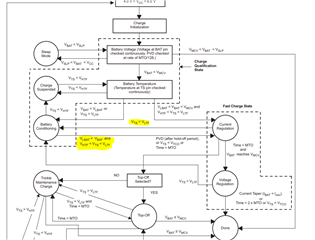Hello everyone,
I'm using the BQ2000 in a project. The IC should charge 2 NiMH battery while the device is connected to USB.
The device is controlled by a micro and the micro should be able to enable/disable the charge.
The device works fine and recharge batteries properly.
The issue I'm having is on disable and enable it.
I was supposing that I could use the TS pin in order to stop/retrieve the charge.
The TS pin is usually 40%Vcc through a resistor partition. The pull up resistor can be shorted using a PMOS put in parallel.
If I turn on the pmos the VTS will go higher the VLTF, when I turn it off VTS will go back at VHTF<VTS<VLTF.

As for the state diagram (page 4 of teh datasheet) I expected to pass from Current regulation to Battery conditioning putting VTS = VCC.
Then putting back the VTS = 0,4*VCC I expected (still being VBAT>VLBAT) that the IC will turn back on Current regulation state.
But that doesn't happend and to restart the charge I must disconnect and reconnect batteries or power supply.
Is cutting VCC the correct (and only) way to control the BQ2000?

